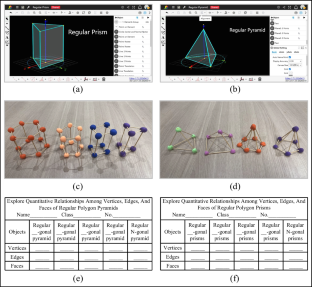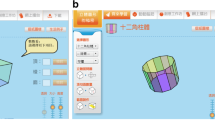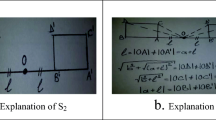Abstract
Mathematical inquiry involving hands-on activities has received increasing attention in mathematics education. Besides various customized physical teaching aids, subject-specific information technology, such as Dynamic Geometry System (DGS), finds extensive use in mathematical inquiry activities. However, effects of DGS and physical manipulatives on inquiry-based math learning remain an open question. Hence, by adopting a quasi-experimental research design, this paper aims to empirically compare the immediate learning outcomes, knowledge retention, and learning interest of seventh-grade students who explore with virtual manipulatives (i.e., the DGS) and who explore with physical manipulatives. Specifically, 131 students participated in learning activities centered on exploring pyramids and prisms. During the inquiry process, Group A (n = 33) constructed pyramids and prisms in DGS, Group B (n = 34) observed pre-made virtual models in DGS, Group C (n = 32) observed physical models, and Group D (n = 32) made physical pyramids and prisms with polymer clay and small sticks. Moreover, pretest, post-test, and delayed post-test designed according to the Van Hiele model, as well as an adapted interest questionnaire, were employed to evaluate students’ performances; and collected data were analyzed by means of ANCOVA and t-test. Findings of the study revealed that in the context of construction, students employing the DGS exhibited superior immediate learning outcomes and greater knowledge retention compared to their peers who utilized physical manipulatives; while in the case of observation, the virtual and physical manipulatives yielded similar impacts on students’ immediate learning outcomes, but students who involved in the DGS demonstrated higher knowledge retention. Furthermore, regarding the DGS environment, students who engaged in constructive manipulation surpassed their peers who engaged in observing manipulation. In terms of interest, the DGS proved to be more effective in both stimulating and maintaining higher interest compared to the physical manipulatives, and constructive manipulation was more effective than observing manipulation. In summary, as compared to the physical manipulatives, DGS, particularly when employed with constructive strategy, has shown to encourage students to more actively engage in task-related cognitive behaviors, thereby supporting and enhancing inquiry-based math learning of students in junior high school.



Similar content being viewed by others
Data availability
The datasets used or analyzed during the current study are available from the author on reasonable request.
References
Anderson, R. D. (2002). Reforming science teaching: What research says about inquiry. Journal of Science Teacher Education, 13(1), 1–12. https://doi.org/10.1023/A:1015171124982.
Artigue, M., & Blomhøj, M. (2013). Conceptualizing inquiry-based education in mathematics. Zdm, 45, 797–810. https://doi.org/10.1007/s11858-013-0506-6.
Aydede, M. (1999). What makes perceptual symbols perceptual? Behavioral and Brain Sciences, 22(4), 610–611. https://doi.org/10.1017/S0140525X99232141.
Ayres, P. (2020). Something old, something new from cognitive load theory. Computers in Human Behavior, 113, 106503. https://doi.org/10.1016/j.chb.2020.106503.
Baki, A., Kösa, T., & Güven, B. (2011). A comparative study of the effects of using dynamic geometry software and physical manipulatives on the spatial visualisation skills of pre-service mathematics teachers. British Journal of Educational Technology, 42(2), 291–310. https://doi.org/10.1111/j.1467-8535.2009.01012.x.
Baudon, O., & Laborde, J. (1996). Cabri-graph, a sketchpad for graph theory. Mathematics and Computers in Simulation, 42, 765–774. https://doi.org/10.1016/S0378-4754(96)00049-3.
Bokosmaty, S., Mavilidi, M., & Paas, F. (2017). Making versus observing manipulations of geometric properties of triangles to learn geometry using dynamic geometry software. Computers & Education, 113, 313–326. https://doi.org/10.1016/j.compedu.2017.06.008.
Broda, M. D., Ross, E., Sorhagen, N. S., & Ekholm, E. (2023). Exploring control-value motivational profiles of mathematics anxiety, self-concept, and interest in adolescents. Frontiers in Psychology, 14:1140924. https://doi.org/10.3389/fpsyg.2023.1140924.
Chan, K. K., & Leung, S. W. (2014). Dynamic geometry software improves mathematical achievement: Systematic review and meta-analysis. Journal of Educational Computing Research, 51(3), 311–325. https://doi.org/10.2190/EC.51.3.c.
Disbudak, O., & Akyuz, D. (2019). The comparative effects of concrete manipulatives and dynamic software on the geometry achievement of fifth-grade students. International Journal for Technology in Mathematics Education, 26(1), 3–20. https://doi.org/10.1564/TME_V26.1.01.
Donnelly-Hermosillo, D. F., Gerard, L. F., & Linn, M. C. (2020). Impact of graph technologies in K-12 science and mathematics education. Computers & Education, 62, 62–71. https://doi.org/10.1016/j.compedu.2019.103748.
Dorier, J., & Mass, K. (2020). Inquiry-based mathematics education. Encyclopedia of mathematics education. In S. Lerman (Ed.), Encyclopedia of Mathematics Education (pp. 384–388). Springer. https://doi.org/10.1007/978-3-030-15789-0_176.
Erbas, A. K., & Yenmez, A. A. (2011). The effect of inquiry-based explorations in a dynamic geometry environment on sixth grade students’ achievements in polygons. Computers & Education, 57, 2462–2475. https://doi.org/10.1016/j.compedu.2011.07.002.
Georgiou, Y., Ioannou, A., & Kosmas, P. (2021). Comparing a digital and a non-digital embodied learning intervention in geometry: Can technology facilitate? Technology Pedagogy and Education, 30(2), 345–363. https://doi.org/10.1080/1475939X.2021.1874501.
Giardino, V. (2022). Experimenting with triangles. Axiomathes, 32(1), 55–77. https://doi.org/10.1007/s10516-022-09639-x.
Gibbons, A. S., Mcconkie, M., Seo, K. K., & Wiley, D. (2009). Simulation approach to instruction. In D. Ifenthaler, P. Pirnay-Dummer, & J. M. Spector (Eds.), Instructional-design theories and models (pp. 3–38). Springer. https://doi.org/10.4324/9780203872130-16.
Gilligan-Lee, K., Hawes, Z., Williams, A. Y., Farran, E. K., & Mix, K. S. (2023). Hands-On: Investigating the role of physical manipulatives in spatial training. Child Development, 94(5), 1205–1221. https://doi.org/10.1111/cdev.13963.
Gómez-Chacón, I. M., Bacelo, A., Marbán, J. M., & Palacios, A. (2023). Inquiry-based mathematics education and attitudes towards mathematics: Tracking profiles for teaching. Mathematics Education Research Journal. https://doi.org/10.1007/s13394-023-00468-8.
Gordon, R., & Ramani, G. B. (2021). Integrating Embodied Cognition and Information Processing: A Combined Model of the Role of Gesture in Children’s Mathematical Environments. Frontiers in Psychology, 12, https://doi.org/10.3389/fpsyg.2021.650286.
Guan, H., Qin, X. L., & Rao, Y. S. (2019). Research and design of dynamic mathematical digital resources open platform. Journal of Harbin Institute of Technology, 51(5), 14–22. https://doi.org/10.11918/j.issn.0367-6234.201811037.
Guan, H., Qin, X. L., Rao, Y. S., & Cao, S. (2020). Domain model of web-based dynamic geometry software and its applications. Journal of Computer Applications, 40(4). https://doi.org/10.11772/j.issn.1001-9081.2019091672.
Guan, H., Rao, Y., Zhang, J., Cao, S., & Qin, X. (2021). Method for processing graph degeneracy in dynamic geometry based on domain design. Journal of Computer Science and Technology, 36, 910–921. https://doi.org/10.1007/s11390-021-0095-8.
Harlen, W. (2013). Inquiry-based learning in science and mathematics. Review of Science Mathematics and ICT Education, 7(2), 9–33. https://doi.org/10.26220/rev.2042.
Hidi, S., & Baird, W. (1988). Strategies for increasing text-based interest and students’ recall of expository texts. Reading Research Quarterly, 23(4), 465–483. https://doi.org/10.2307/747644.
Hidi, S., & Renninger, A. (2006). The four-phase model of Interest Development. Educational Psychologist, 41(2), 111–127. https://doi.org/10.1207/s15326985ep4102_4.
Hillmayr, D., Ziernwald, L., Reinhold, F., Hofer, S. I., & Reiss, K. M. (2020). The potential of digital tools to enhance mathematics and science learning in secondary schools: A context-specific meta-analysis. Computers & Education, 153, 103897. https://doi.org/10.1016/j.compedu.2020.103897.
Hu, F., Ginns, P., & Bobis, J. (2015). Getting the point: Tracing worked examples enhances learning. Learning and Instruction, 35, 85–93. https://doi.org/10.1016/j.learninstruc.2014.10.002.
Jiang, P. J., Niu, W. Q., & Xiong, B. (2020). A literature review of the integration of information technology into mathematics instruction in China. Journal of Mathematics Education, 29(4), 96–102.
Kalyuga, S. (2011). Cognitive load theory: How many types of load does it really need? Educational Psychology Review, 23, 1–19. https://doi.org/10.1007/s10648-010-9150-7.
Kapici, H. O., Akçay, H., & de Jong, T. (2019). Using hands-on and virtual laboratories alone or together-which works better for acquiring knowledge and skills? Journal of Science Education and Technology, 28, 231–250. https://doi.org/10.1007/s10956-018-9762-0.
Karakuş, F., & Peker, M. (2015). The effects of dynamic geometry software and physical manipulatives on pre-service primary teachers’ van hiele levels and spatial abilities. Turkish Journal of Computer and Mathematics Education, 6, 338–365. https://doi.org/10.16949/TURCOMAT.31338.
Kortenkamp, U., & Richter-Gebert, J. (2002). Making The Move: The Next Version Of Cinderella. In: Cohen, A, M. (Eds.), Mathematical Software(pp. 208–216). World Scientific. https://doi.org/10.1142/9789812777171_0021.
Koskinen, A., McMullen, J., Hannula-Sormunen, M. M., Ninaus, M., & Kiili, K. (2023). The strength and direction of the difficulty adaptation affect situational interest in game-based learning. Computers & Education, 194, 104694. https://doi.org/10.1016/j.compedu.2022.104694.
Lee, H., & Boo, E. (2022). The effects of teachers’ instructional styles on students’ interest in learning school subjects and academic achievement: Differences according to students’ gender and prior interest. Learning and individual differences. Learning and Individual Differences, 99, 102200. https://doi.org/10.1016/j.lindif.2022.102200.
Li, M. L., Ding, R. X., Zhang, Y., Liu, W. T., He, H. C., & Liu, H. Q. (2018). From cognitive sciences to learning sciences: The past, the present and the future. Tsinghua Journal of Education, 39(4), 29–39. https://doi.org/10.14138/j.1001-4519.2018.04.002911.
Marshall, J. A., & Young, E. S. (2006). Preservice teachers’ theory development in physical and simulated environments. Journal of Research in Science Teaching, 43(9), 907–937. https://doi.org/10.1002/TEA.20124.
Moyer-Packenham, P. S., & Bolyard, J. J. (2016). Revisiting the definition of a virtual manipulative. In P. Moyer-Packenham (Ed.), International perspectives on Teaching and Learning mathematics with virtual manipulatives (pp. 3–23). Springer. https://doi.org/10.1007/978-3-319-32718-1_1.
Ng, O., Shi, L., & Ting, F. S. (2020). Exploring differences in primary students’ geometry learning outcomes in two technology-enhanced environments: Dynamic geometry and 3d printing. International Journal of STEM Education, 7, 1–13. https://doi.org/10.1186/s40594-020-00244-1.
Ning, L. H. (2005). Characteristic of the study on the inquiry learning of mathematics and reflecting on it. Journal of Mathematics Education, 14(4), 28–30. https://doi.org/10.3969/j.issn.1004-9894.2005.04.007.
Olympiou, G., & Zacharia, Z. C. (2012). Blending physical and virtual manipulatives: An effort to improve students’ conceptual understanding through science laboratory experimentation. Science Education, 96(1), 21–47. https://doi.org/10.1002/sce.20463.
Ondes, R. N. (2021). Research trends in dynamic geometry software: A content analysis from 2005 to 2021. Journal on Educational Technology, 13(2), 236–260. https://doi.org/10.18844/wjet.v13i2.5695.
Pedersen, I. F., & Haavold, P. Ø. (2023). Students’ mathematical beliefs and motivation in the context of inquiry-based mathematics teaching. International Journal of Mathematical Education in Science and Technology, 54(8), 1649–1663. https://doi.org/10.1080/0020739X.2023.2189171.
Peer, M., Brunec, I. K., Newcombe, N. S., & Epstein, R. A. (2020). Structuring knowledge with cognitive maps and cognitive graphs. Trends in Cognitive Sciences, 25, 37–54. https://doi.org/10.1016/j.tics.2020.10.004.
Pezzulo, G., & Calvi, G. (2011). Computational explorations of perceptual symbol systems theory. New Ideas in Psychology, 29(3), 275–297. https://doi.org/10.1016/j.newideapsych.2009.07.004.
Pouw, W., Gog, T. V., & Paas, F. (2014). An embedded and embodied cognition review of instructional manipulatives. Educational Psychology Review, 26(1), 51–72. https://doi.org/10.1007/s10648-014-9255-5.
Quaresma, P., Santos, V., & Maric, M. (2017). WGL, a web laboratory for geometry. Education and Information Technologies, 23, 237–252. https://doi.org/10.1007/s10639-017-9597-y.
Shabat, G., Of, A., & Semenov, R. A. (2023). Computer experiment in Teaching Mathematics. Doklady Mathematics, 107, S92–S116. https://doi.org/10.1134/S1064562423700618.
Shapiro, L. A., & Stolz, S. A. (2018). Embodied cognition and its significance for education. Theory and Research in Education, 17(1), 19–39. https://doi.org/10.1177/1477878518822149.
Sørensen, H. K., Mathiasen, S. K., & Johansen, M. W. (2024). What is an experiment in mathematical practice? New evidence from mining the Mathematical Reviews. Synthese, 203(2), 1–21. https://doi.org/10.1007/s11229-023-04475-x.
Sullah, R. M., Ismail, N., & Abdullah, A. H. (2017). A comparison between virtual and physical manipulatives in geometry learning for standard 2 mathematics. Man in India, 97(17), 235–247.
Sweller, J. (1988). Cognitive load during problem solving: Effects on Learning. Cognitive Science, 12(2), 257–285. https://doi.org/10.1207/s15516709cog1202_4.
Tran, C., Smith, B., & Buschkuehl, M. (2017). Support of mathematical thinking through embodied cognition: Nondigital and digital approaches. Cognitive Research: Principles and Implications, 2(1), 1–18. https://doi.org/10.1186/s41235-017-0053-8.
Ulusoy, F., & Turuş, İ. B. (2022). The mathematical and technological nature of tasks containing the use of dynamic geometry software in middle and secondary school mathematics textbooks. Education and Information Technologies, 27, 11089–11113. https://doi.org/10.1007/s10639-022-11070-z.
Vishnyakov, Y. S., Semenov, A. A., & Shabat, G. (2023). The work of a Mathematician as a Prefiguring of Mastering Mathematics by students: The role of experiments. Doklady Mathematics, 107, S91. https://doi.org/10.1134/S1064562423700606.
Wang, C. X. (2020). Substitution and transcendence of virtual manipulatives to physical manipulatives: From perspective of embodied cognition. e-Education Research, 41(12), 50–58. https://doi.org/10.13811/j.cnki.eer.2020.12.007.
Weisberg, S. M., & Newcombe, N. S. (2017). Embodied cognition and STEM learning:Overview of a topical collection in CR:PI. Cognitive Research: Principles and Implications, 2(1), 38. https://doi.org/10.1186/s41235-017-0071-6.
Xu, Z. T. (2011). Super Sketchpad: An excellent cognitive platform for acquiring basic math activities experiences. Journal of Mathematics Education, 20(3), 97–99.
Ye, B. B., & Feng, M. M. (2019). From materialization, Electronicization to informatization: The evolution of Primary School Mathematics Teaching Aids. Curriculum Teaching Material and Method, 7, 68–75. https://doi.org/10.19877/j.cnki.kcjcjf.2019.07.011.
Ye, H. S. (2023). Embodied mind and embodied education. Educational Research, 44(03), 32–41.
Yuan, Y., Lee, C., & Wang, C. (2010). A comparison study of polyominoes explorations in a physical and virtual manipulative environment. Journal of Computer Assisted Learning, 26(4), 307–316. https://doi.org/10.1111/j.1365-2729.2010.00352.x.
Zambak, V. S., & Tyminski, A. M. (2020). Examining mathematical technological knowledge of pre-service middle grades teachers with Geometer’s Sketchpad in a geometry course. International Journal of Mathematical Education in Science and Technology, 51, 183–207. https://doi.org/10.1080/0020739X.2019.1650302.
Zengin, Y. (2023). Effectiveness of a professional development course based on information and communication technologies on mathematics teachers’ skills in designing technology-enhanced task. Education and Information Technologies. https://doi.org/10.1007/s10639-023-11728-2.
Zhang, J. Z., Chen, R. X., Lu, X. H., Xu, Z. T., & Rao, Y. S. (2022). Research on training model for mathematics teachers’ TPACK under the background of internet+ --taking the Netpad training for middle school mathematics teacher in Wuhou district as an example. Journal of Mathematics Education, 31(5), 1–8.
Zhang, Y., Wang, P., Jia, W., Zhang, A., & Chen, G. (2023). Dynamic visualization by GeoGebra for mathematics learning: A meta-analysis of 20 years of research. Journal of Research on Technology in Education. https://doi.org/10.1080/15391523.2023.2250886.
Acknowledgements
The author thanks in particular the teachers and students who participated in the study. In addition, thanks to Aunt He, who is a dedicated math teacher as well as an enlightened mom.
Funding
This work was supported by the National Natural Science Foundation of China (No. 62172116) and the Innovation Research for the Full-time Postgraduates of Guangzhou University (No. 2022GDJC-M34).
Author information
Authors and Affiliations
Corresponding author
Ethics declarations
Conflict of interest
The authors do not have any possible conflicts of interest.
Additional information
Publisher’s Note
Springer Nature remains neutral with regard to jurisdictional claims in published maps and institutional affiliations.
Rights and permissions
Springer Nature or its licensor (e.g. a society or other partner) holds exclusive rights to this article under a publishing agreement with the author(s) or other rightsholder(s); author self-archiving of the accepted manuscript version of this article is solely governed by the terms of such publishing agreement and applicable law.
About this article
Cite this article
Guan, H., Li, J., Rao, Y. et al. Comparative effects of dynamic geometry system and physical manipulatives on Inquiry-based Math Learning for students in Junior High School. Educ Inf Technol (2024). https://doi.org/10.1007/s10639-024-12663-6
Received:
Accepted:
Published:
DOI: https://doi.org/10.1007/s10639-024-12663-6




